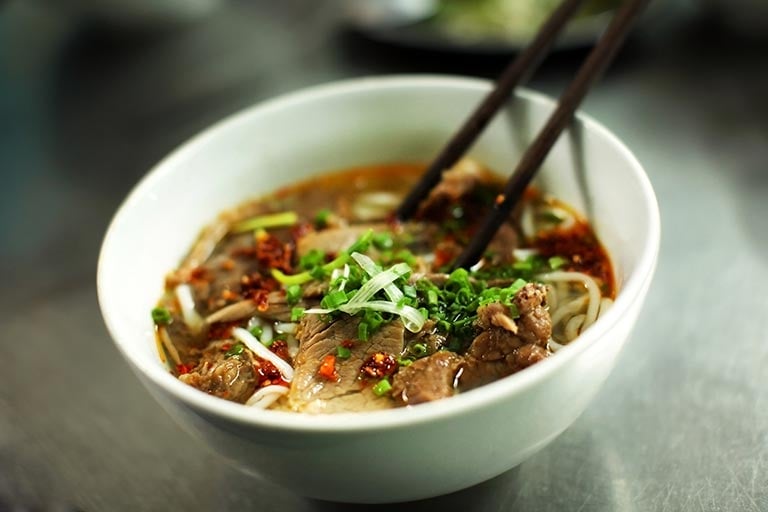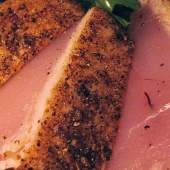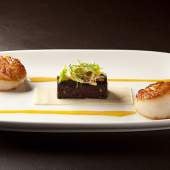Vietnam

The latest film from Ken Burns and Lynn Novick, The Vietnam War, premieres on WTTW11 and wttw.com on Sunday, September 17. Perhaps it’s an appropriate time for a look at Vietnamese cuisine, which is a distinctly aromatic combination of disparate flavors and textures designed to engage all five senses. It is a compendium of culinary contrasts: sweet and sour, mild and spicy, cold and hot — a true example, if you will, of yin and yang. If your idea of good eating is a little bit of everything (with a generous amount of fish sauce!), you should definitely give this cuisine a try.
As most people know, Vietnam is located in Southeast Asia — its long, narrow “S” shape covers an area about the size of Italy, with a population of approximately 95.5 million. Its cuisine is heavily influenced by its neighbors China, Cambodia, Laos, and Thailand; and, of course, by its coastal location abutting the South China Sea. There’s also a dash of France thrown in for good measure, thanks to a couple of centuries of French colonization.
As is so often the case, where you find yourself in the country dictates the categories of foods you will find. Serious Eats describes it this way: “The food of the north is heavily influenced by China with its stir-fries and noodle-based soups. As you move south, there's more flavor-blending with nearby Thailand and Cambodia. The tropical climate down south also sustains more rice paddies, coconut groves, jackfruit trees, and herb gardens. The food in southern Vietnam is typically sweeter: sweeter broths for pho, more palm sugar used in savory dishes, and those popular taffy-like coconut candies made with coconut cream.”
Jackfruit
When referring to Vietnamese food in general, the staples include rice, fish sauce, herbs and spices, protein, and fruit. One category that is not prominent: dairy — you won’t find much in the way of butter, cheese, cream, or fresh milk (what you’ll find is condensed milk, more often than not).
What are some Vietnamese mainstays?
- Phở – If Vietnam has a national dish, this is it: a generously spiced, aromatic noodle soup (especially good when you have a cold!). It’s thought that “Pho,” pronounced “fuh,” is reminiscent of the French term “feu,” as in “pot-au-feu.” It combines rice noodles and a variety of herbs and meat broths. By the way, a prospective bride’s skill (or lack thereof) at making broth is an important factor in obtaining the seal of approval from her future mother-in-law. So broth is quite a serious pursuit in Vietnam.
- Bánh mì – This is where France enters the Vietnamese culinary arena — this is a very popular sandwich on a crusty French baguette, and its fillings can include everything from pork belly, meatballs, head cheese, pate, fish cakes, pickled carrots, cilantro, and hot chilies. Really, really hot chilies.
- Chả giò – Every Asian country seems to have its own version of spring rolls — the Vietnamese like theirs wrapped in rice paper encompassing minced crab, shrimp, or pork, rolled with greens and herbs, and served with lettuce. There is a fruit-filled variety as well, and all of these are often paired with a peanut sauce (as in Thai food). There are also salad rolls (Gỏi cuốn), which, surprisingly, are not necessarily meatless.
- Bánh xèo – In English, this means “sizzling pancake,” and that’s exactly what it is — a thin disk with crisp edges reminiscent of a crèpe made with coconut milk, herbs, and rice flour, and colored with turmeric. It’s best eaten hot out of the pan.
- Rau Muong – This is probably Vietnam’s most ubiquitous vegetable. It’s known as morning glory or water spinach, and is often found in stir-fry or as an ingredient in phở.
- Bánh cuốn – These are a form of soft, light rice “pockets” popular for breakfast — a batter is rolled into a thin sheet, steamed, and folded around seasoned ground pork and minced shallots and mushrooms. Dip them into some nice Nước chắm, and eat!
- Chè – Soup (or pudding) adapted as a dessert, topped with dried or jellied fruits. Ingredients can include mangoes and other cooked fruits, plus mung and black beans. For a true sugar rush, have it with…
- Ca Phe – If you like really strong, rich, dark roasted coffee, you’re in luck — this specialty of Hanoi could also be considered dessert, as it is topped with a foam made from sweetened condensed milk and whisked raw egg. (Hint: you might have trouble sleeping later.) If raw eggs aren’t your thing, you can always go for an iced coffee with sweetened condensed milk.
A few basic etiquette pointers — meals are usually served family style, so never eat out of the serving dish but from your own bowl or plate. Meat is generally the priciest ingredient, so be sure to leave plenty for others. Use two hands for passing dishes around the table, which will more than likely be very close to the ground. If you’re not proficient with chopsticks, it’s fine to ask for utensils — but explain why. If you do use chopsticks, don’t stick them vertically in your food when taking a break to drink. Finally, don’t take more food than you can eat — it’s considered rude to leave anything on your plate.
Got all that, and want to experience Vietnamese food in Chicago? Check, Please! has got you covered. Chúc ngon miệng! (Enjoy your meal!)





